HA2032 Corporate & Financial Accounting: Regulation, Equity Analysis
VerifiedAdded on 2023/06/08
|11
|3132
|386
Report
AI Summary
This report provides an analysis of corporate regulation, accounting standard setting, and owner's equity, focusing on the Australian context and international standards. It discusses the benefits of regulating financial accounting and reporting, comparing mandatory and voluntary disclosure. The report also examines the roles of the International Accounting Standards Board (IASB) and the Australian Accounting Standards Board (AASB), and the adoption of IFRS standards. Furthermore, it analyzes the owner's equity structures of several Australian mining companies, including BHP Billiton Ltd, Australia United Mining Limited, Evolution Mining Ltd, and Fortescue Metal Group Ltd, evaluating their return on equity and dividend policies. Desklib offers a wide array of solved assignments and resources for students.
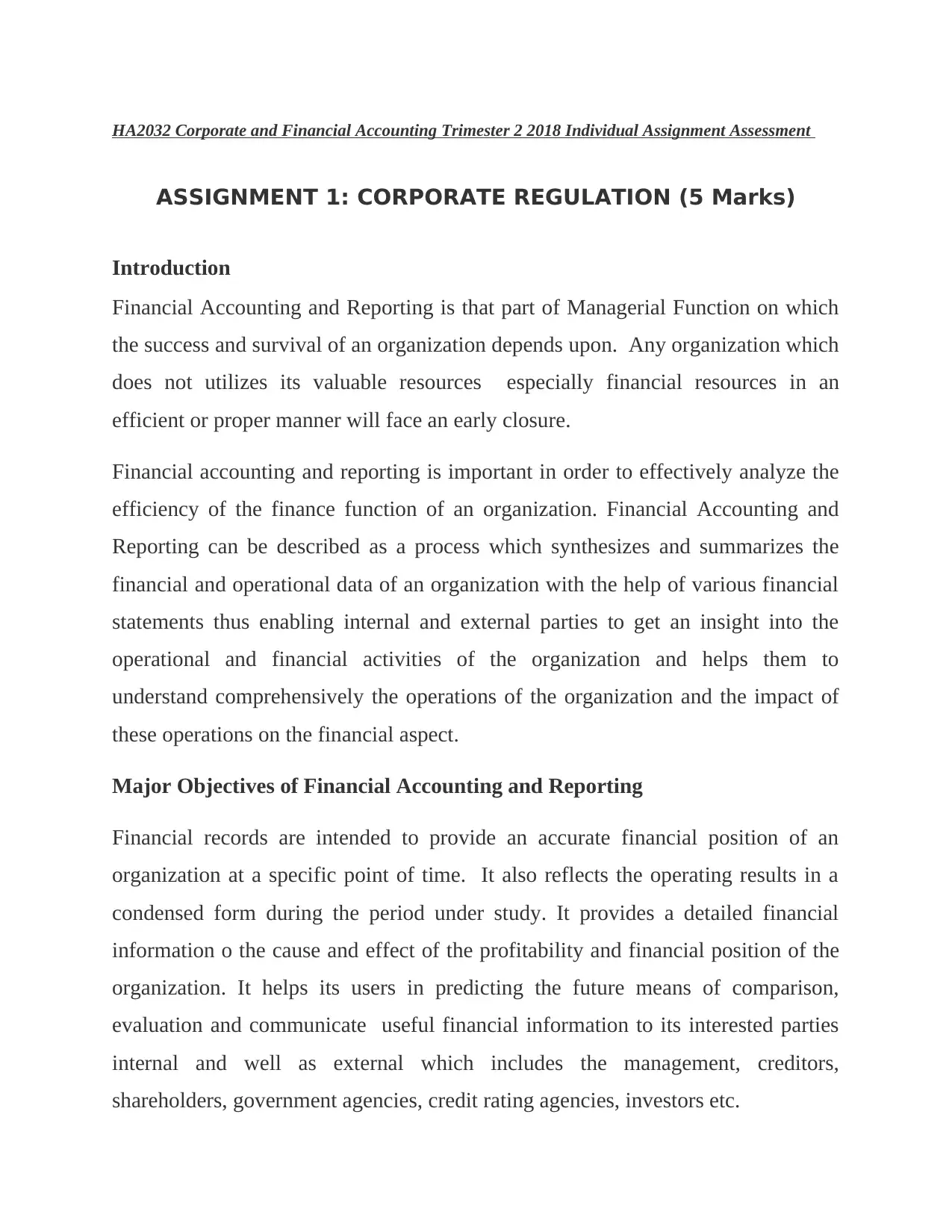
HA2032 Corporate and Financial Accounting Trimester 2 2018 Individual Assignment Assessment
ASSIGNMENT 1: CORPORATE REGULATION (5 Marks)
Introduction
Financial Accounting and Reporting is that part of Managerial Function on which
the success and survival of an organization depends upon. Any organization which
does not utilizes its valuable resources especially financial resources in an
efficient or proper manner will face an early closure.
Financial accounting and reporting is important in order to effectively analyze the
efficiency of the finance function of an organization. Financial Accounting and
Reporting can be described as a process which synthesizes and summarizes the
financial and operational data of an organization with the help of various financial
statements thus enabling internal and external parties to get an insight into the
operational and financial activities of the organization and helps them to
understand comprehensively the operations of the organization and the impact of
these operations on the financial aspect.
Major Objectives of Financial Accounting and Reporting
Financial records are intended to provide an accurate financial position of an
organization at a specific point of time. It also reflects the operating results in a
condensed form during the period under study. It provides a detailed financial
information o the cause and effect of the profitability and financial position of the
organization. It helps its users in predicting the future means of comparison,
evaluation and communicate useful financial information to its interested parties
internal and well as external which includes the management, creditors,
shareholders, government agencies, credit rating agencies, investors etc.
ASSIGNMENT 1: CORPORATE REGULATION (5 Marks)
Introduction
Financial Accounting and Reporting is that part of Managerial Function on which
the success and survival of an organization depends upon. Any organization which
does not utilizes its valuable resources especially financial resources in an
efficient or proper manner will face an early closure.
Financial accounting and reporting is important in order to effectively analyze the
efficiency of the finance function of an organization. Financial Accounting and
Reporting can be described as a process which synthesizes and summarizes the
financial and operational data of an organization with the help of various financial
statements thus enabling internal and external parties to get an insight into the
operational and financial activities of the organization and helps them to
understand comprehensively the operations of the organization and the impact of
these operations on the financial aspect.
Major Objectives of Financial Accounting and Reporting
Financial records are intended to provide an accurate financial position of an
organization at a specific point of time. It also reflects the operating results in a
condensed form during the period under study. It provides a detailed financial
information o the cause and effect of the profitability and financial position of the
organization. It helps its users in predicting the future means of comparison,
evaluation and communicate useful financial information to its interested parties
internal and well as external which includes the management, creditors,
shareholders, government agencies, credit rating agencies, investors etc.
Paraphrase This Document
Need a fresh take? Get an instant paraphrase of this document with our AI Paraphraser
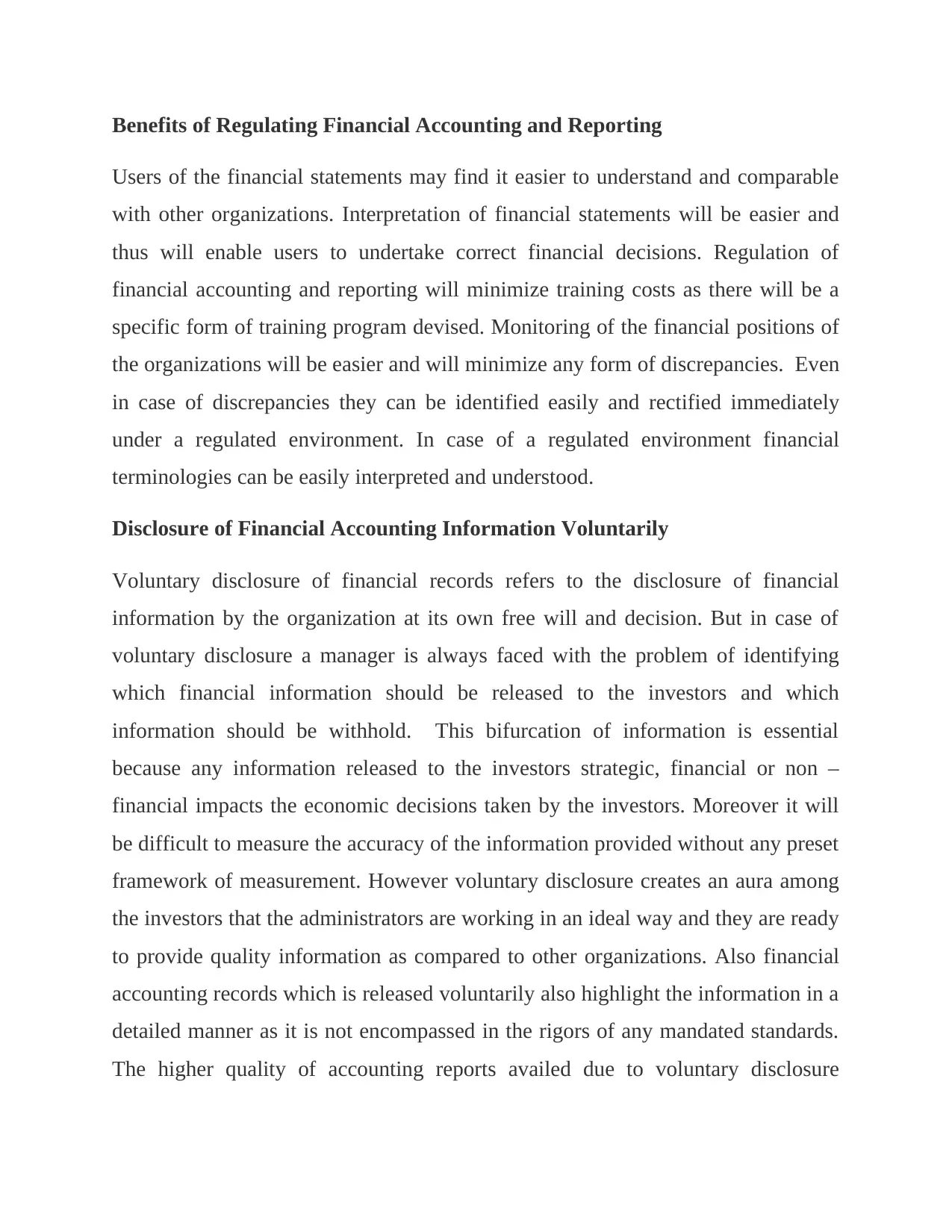
Benefits of Regulating Financial Accounting and Reporting
Users of the financial statements may find it easier to understand and comparable
with other organizations. Interpretation of financial statements will be easier and
thus will enable users to undertake correct financial decisions. Regulation of
financial accounting and reporting will minimize training costs as there will be a
specific form of training program devised. Monitoring of the financial positions of
the organizations will be easier and will minimize any form of discrepancies. Even
in case of discrepancies they can be identified easily and rectified immediately
under a regulated environment. In case of a regulated environment financial
terminologies can be easily interpreted and understood.
Disclosure of Financial Accounting Information Voluntarily
Voluntary disclosure of financial records refers to the disclosure of financial
information by the organization at its own free will and decision. But in case of
voluntary disclosure a manager is always faced with the problem of identifying
which financial information should be released to the investors and which
information should be withhold. This bifurcation of information is essential
because any information released to the investors strategic, financial or non –
financial impacts the economic decisions taken by the investors. Moreover it will
be difficult to measure the accuracy of the information provided without any preset
framework of measurement. However voluntary disclosure creates an aura among
the investors that the administrators are working in an ideal way and they are ready
to provide quality information as compared to other organizations. Also financial
accounting records which is released voluntarily also highlight the information in a
detailed manner as it is not encompassed in the rigors of any mandated standards.
The higher quality of accounting reports availed due to voluntary disclosure
Users of the financial statements may find it easier to understand and comparable
with other organizations. Interpretation of financial statements will be easier and
thus will enable users to undertake correct financial decisions. Regulation of
financial accounting and reporting will minimize training costs as there will be a
specific form of training program devised. Monitoring of the financial positions of
the organizations will be easier and will minimize any form of discrepancies. Even
in case of discrepancies they can be identified easily and rectified immediately
under a regulated environment. In case of a regulated environment financial
terminologies can be easily interpreted and understood.
Disclosure of Financial Accounting Information Voluntarily
Voluntary disclosure of financial records refers to the disclosure of financial
information by the organization at its own free will and decision. But in case of
voluntary disclosure a manager is always faced with the problem of identifying
which financial information should be released to the investors and which
information should be withhold. This bifurcation of information is essential
because any information released to the investors strategic, financial or non –
financial impacts the economic decisions taken by the investors. Moreover it will
be difficult to measure the accuracy of the information provided without any preset
framework of measurement. However voluntary disclosure creates an aura among
the investors that the administrators are working in an ideal way and they are ready
to provide quality information as compared to other organizations. Also financial
accounting records which is released voluntarily also highlight the information in a
detailed manner as it is not encompassed in the rigors of any mandated standards.
The higher quality of accounting reports availed due to voluntary disclosure
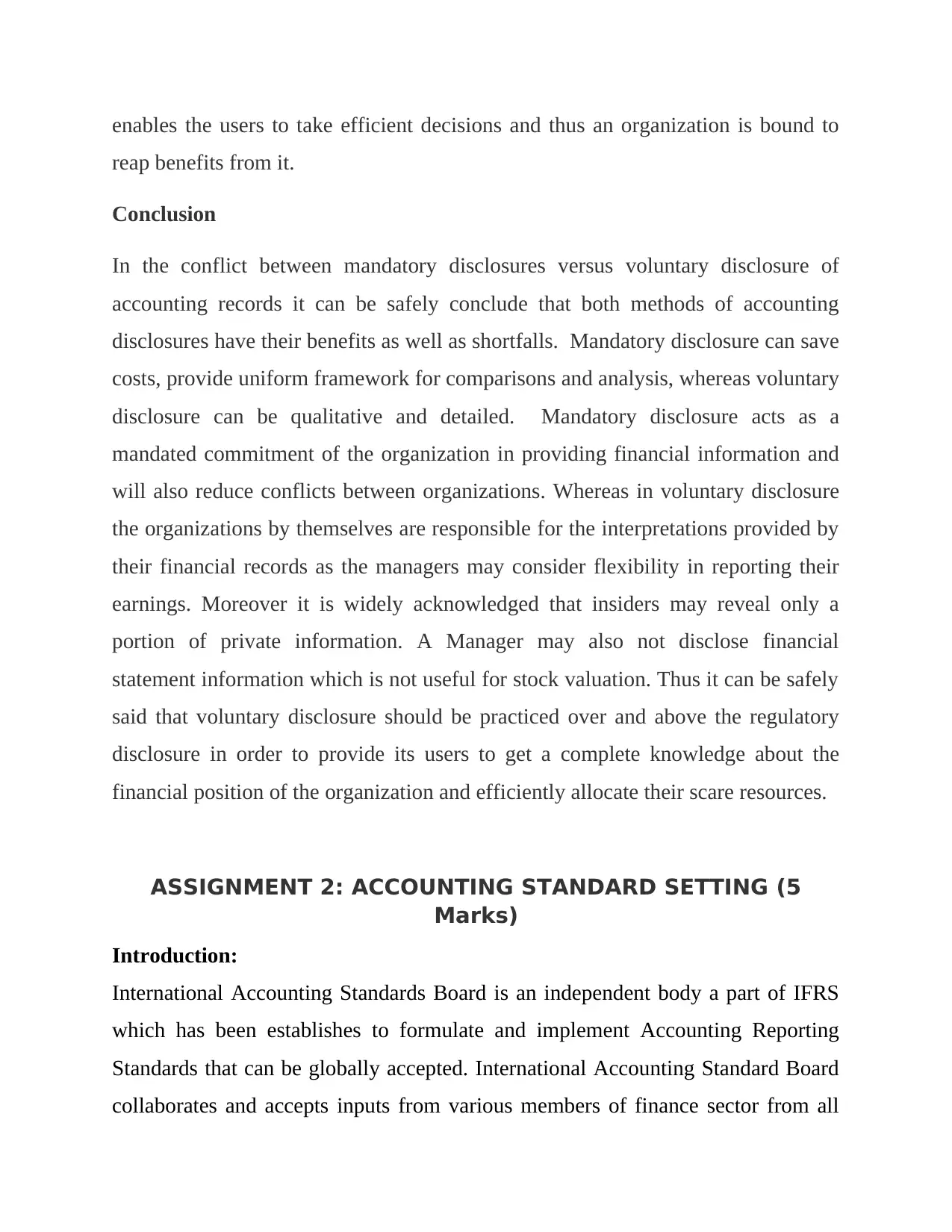
enables the users to take efficient decisions and thus an organization is bound to
reap benefits from it.
Conclusion
In the conflict between mandatory disclosures versus voluntary disclosure of
accounting records it can be safely conclude that both methods of accounting
disclosures have their benefits as well as shortfalls. Mandatory disclosure can save
costs, provide uniform framework for comparisons and analysis, whereas voluntary
disclosure can be qualitative and detailed. Mandatory disclosure acts as a
mandated commitment of the organization in providing financial information and
will also reduce conflicts between organizations. Whereas in voluntary disclosure
the organizations by themselves are responsible for the interpretations provided by
their financial records as the managers may consider flexibility in reporting their
earnings. Moreover it is widely acknowledged that insiders may reveal only a
portion of private information. A Manager may also not disclose financial
statement information which is not useful for stock valuation. Thus it can be safely
said that voluntary disclosure should be practiced over and above the regulatory
disclosure in order to provide its users to get a complete knowledge about the
financial position of the organization and efficiently allocate their scare resources.
ASSIGNMENT 2: ACCOUNTING STANDARD SETTING (5
Marks)
Introduction:
International Accounting Standards Board is an independent body a part of IFRS
which has been establishes to formulate and implement Accounting Reporting
Standards that can be globally accepted. International Accounting Standard Board
collaborates and accepts inputs from various members of finance sector from all
reap benefits from it.
Conclusion
In the conflict between mandatory disclosures versus voluntary disclosure of
accounting records it can be safely conclude that both methods of accounting
disclosures have their benefits as well as shortfalls. Mandatory disclosure can save
costs, provide uniform framework for comparisons and analysis, whereas voluntary
disclosure can be qualitative and detailed. Mandatory disclosure acts as a
mandated commitment of the organization in providing financial information and
will also reduce conflicts between organizations. Whereas in voluntary disclosure
the organizations by themselves are responsible for the interpretations provided by
their financial records as the managers may consider flexibility in reporting their
earnings. Moreover it is widely acknowledged that insiders may reveal only a
portion of private information. A Manager may also not disclose financial
statement information which is not useful for stock valuation. Thus it can be safely
said that voluntary disclosure should be practiced over and above the regulatory
disclosure in order to provide its users to get a complete knowledge about the
financial position of the organization and efficiently allocate their scare resources.
ASSIGNMENT 2: ACCOUNTING STANDARD SETTING (5
Marks)
Introduction:
International Accounting Standards Board is an independent body a part of IFRS
which has been establishes to formulate and implement Accounting Reporting
Standards that can be globally accepted. International Accounting Standard Board
collaborates and accepts inputs from various members of finance sector from all
⊘ This is a preview!⊘
Do you want full access?
Subscribe today to unlock all pages.

Trusted by 1+ million students worldwide
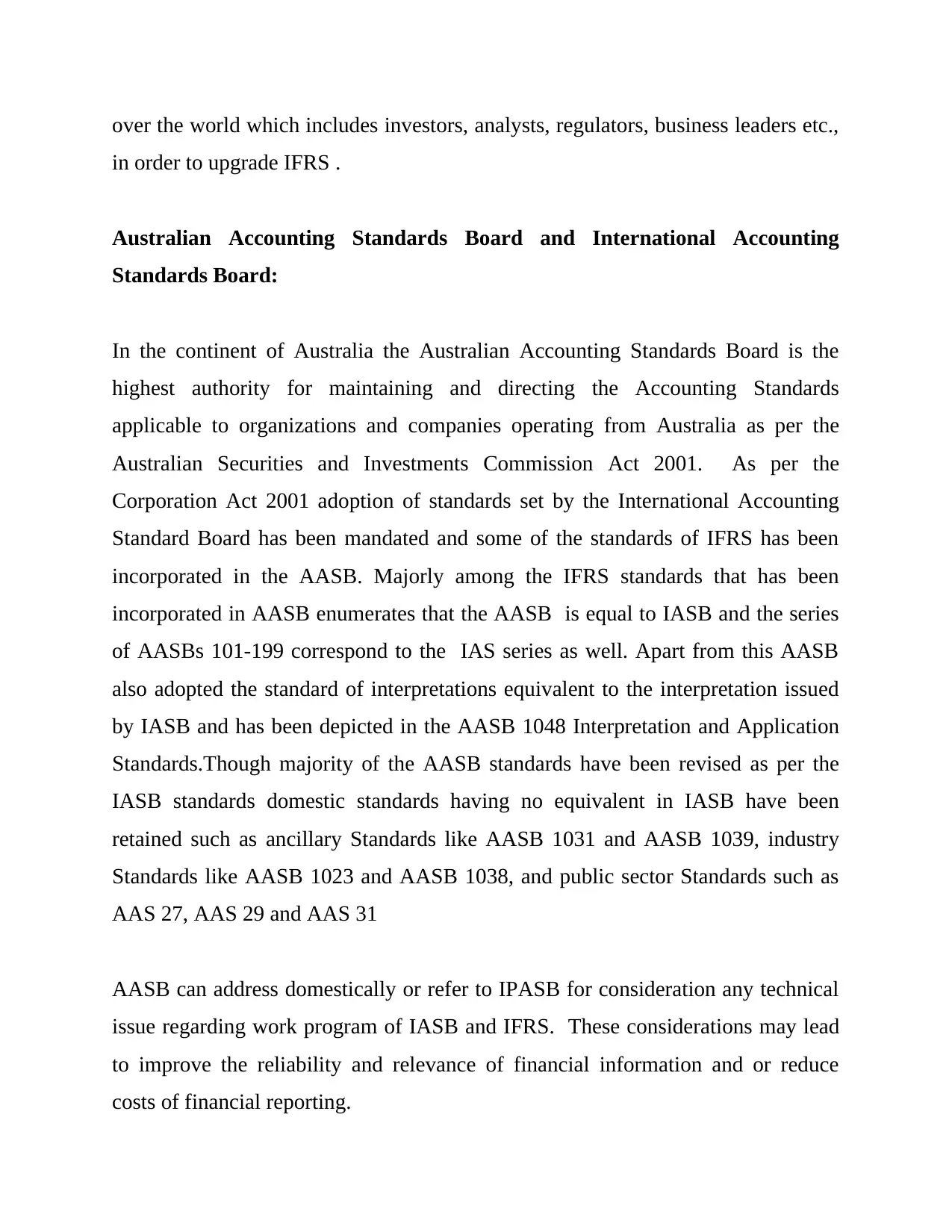
over the world which includes investors, analysts, regulators, business leaders etc.,
in order to upgrade IFRS .
Australian Accounting Standards Board and International Accounting
Standards Board:
In the continent of Australia the Australian Accounting Standards Board is the
highest authority for maintaining and directing the Accounting Standards
applicable to organizations and companies operating from Australia as per the
Australian Securities and Investments Commission Act 2001. As per the
Corporation Act 2001 adoption of standards set by the International Accounting
Standard Board has been mandated and some of the standards of IFRS has been
incorporated in the AASB. Majorly among the IFRS standards that has been
incorporated in AASB enumerates that the AASB is equal to IASB and the series
of AASBs 101-199 correspond to the IAS series as well. Apart from this AASB
also adopted the standard of interpretations equivalent to the interpretation issued
by IASB and has been depicted in the AASB 1048 Interpretation and Application
Standards.Though majority of the AASB standards have been revised as per the
IASB standards domestic standards having no equivalent in IASB have been
retained such as ancillary Standards like AASB 1031 and AASB 1039, industry
Standards like AASB 1023 and AASB 1038, and public sector Standards such as
AAS 27, AAS 29 and AAS 31
AASB can address domestically or refer to IPASB for consideration any technical
issue regarding work program of IASB and IFRS. These considerations may lead
to improve the reliability and relevance of financial information and or reduce
costs of financial reporting.
in order to upgrade IFRS .
Australian Accounting Standards Board and International Accounting
Standards Board:
In the continent of Australia the Australian Accounting Standards Board is the
highest authority for maintaining and directing the Accounting Standards
applicable to organizations and companies operating from Australia as per the
Australian Securities and Investments Commission Act 2001. As per the
Corporation Act 2001 adoption of standards set by the International Accounting
Standard Board has been mandated and some of the standards of IFRS has been
incorporated in the AASB. Majorly among the IFRS standards that has been
incorporated in AASB enumerates that the AASB is equal to IASB and the series
of AASBs 101-199 correspond to the IAS series as well. Apart from this AASB
also adopted the standard of interpretations equivalent to the interpretation issued
by IASB and has been depicted in the AASB 1048 Interpretation and Application
Standards.Though majority of the AASB standards have been revised as per the
IASB standards domestic standards having no equivalent in IASB have been
retained such as ancillary Standards like AASB 1031 and AASB 1039, industry
Standards like AASB 1023 and AASB 1038, and public sector Standards such as
AAS 27, AAS 29 and AAS 31
AASB can address domestically or refer to IPASB for consideration any technical
issue regarding work program of IASB and IFRS. These considerations may lead
to improve the reliability and relevance of financial information and or reduce
costs of financial reporting.
Paraphrase This Document
Need a fresh take? Get an instant paraphrase of this document with our AI Paraphraser
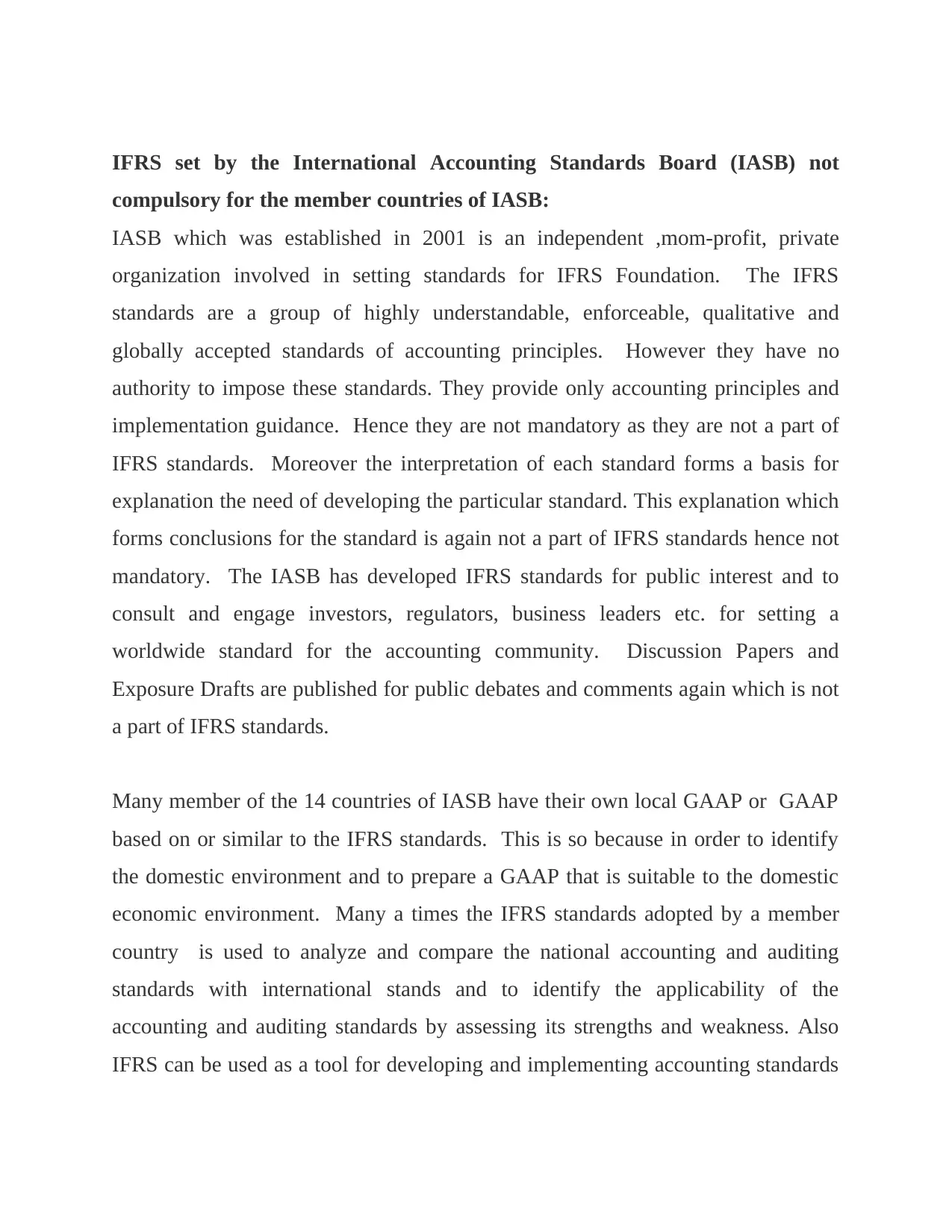
IFRS set by the International Accounting Standards Board (IASB) not
compulsory for the member countries of IASB:
IASB which was established in 2001 is an independent ,mom-profit, private
organization involved in setting standards for IFRS Foundation. The IFRS
standards are a group of highly understandable, enforceable, qualitative and
globally accepted standards of accounting principles. However they have no
authority to impose these standards. They provide only accounting principles and
implementation guidance. Hence they are not mandatory as they are not a part of
IFRS standards. Moreover the interpretation of each standard forms a basis for
explanation the need of developing the particular standard. This explanation which
forms conclusions for the standard is again not a part of IFRS standards hence not
mandatory. The IASB has developed IFRS standards for public interest and to
consult and engage investors, regulators, business leaders etc. for setting a
worldwide standard for the accounting community. Discussion Papers and
Exposure Drafts are published for public debates and comments again which is not
a part of IFRS standards.
Many member of the 14 countries of IASB have their own local GAAP or GAAP
based on or similar to the IFRS standards. This is so because in order to identify
the domestic environment and to prepare a GAAP that is suitable to the domestic
economic environment. Many a times the IFRS standards adopted by a member
country is used to analyze and compare the national accounting and auditing
standards with international stands and to identify the applicability of the
accounting and auditing standards by assessing its strengths and weakness. Also
IFRS can be used as a tool for developing and implementing accounting standards
compulsory for the member countries of IASB:
IASB which was established in 2001 is an independent ,mom-profit, private
organization involved in setting standards for IFRS Foundation. The IFRS
standards are a group of highly understandable, enforceable, qualitative and
globally accepted standards of accounting principles. However they have no
authority to impose these standards. They provide only accounting principles and
implementation guidance. Hence they are not mandatory as they are not a part of
IFRS standards. Moreover the interpretation of each standard forms a basis for
explanation the need of developing the particular standard. This explanation which
forms conclusions for the standard is again not a part of IFRS standards hence not
mandatory. The IASB has developed IFRS standards for public interest and to
consult and engage investors, regulators, business leaders etc. for setting a
worldwide standard for the accounting community. Discussion Papers and
Exposure Drafts are published for public debates and comments again which is not
a part of IFRS standards.
Many member of the 14 countries of IASB have their own local GAAP or GAAP
based on or similar to the IFRS standards. This is so because in order to identify
the domestic environment and to prepare a GAAP that is suitable to the domestic
economic environment. Many a times the IFRS standards adopted by a member
country is used to analyze and compare the national accounting and auditing
standards with international stands and to identify the applicability of the
accounting and auditing standards by assessing its strengths and weakness. Also
IFRS can be used as a tool for developing and implementing accounting standards
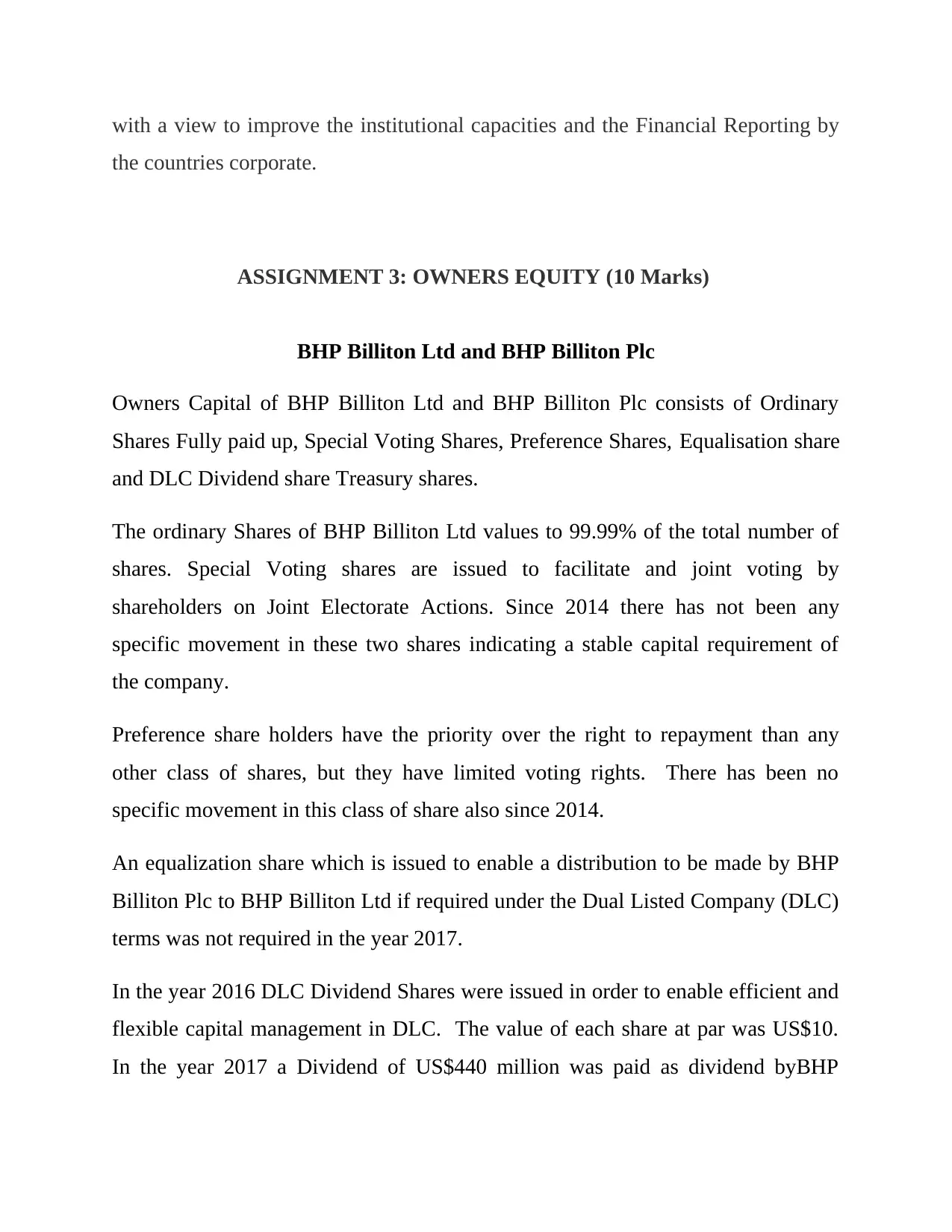
with a view to improve the institutional capacities and the Financial Reporting by
the countries corporate.
ASSIGNMENT 3: OWNERS EQUITY (10 Marks)
BHP Billiton Ltd and BHP Billiton Plc
Owners Capital of BHP Billiton Ltd and BHP Billiton Plc consists of Ordinary
Shares Fully paid up, Special Voting Shares, Preference Shares, Equalisation share
and DLC Dividend share Treasury shares.
The ordinary Shares of BHP Billiton Ltd values to 99.99% of the total number of
shares. Special Voting shares are issued to facilitate and joint voting by
shareholders on Joint Electorate Actions. Since 2014 there has not been any
specific movement in these two shares indicating a stable capital requirement of
the company.
Preference share holders have the priority over the right to repayment than any
other class of shares, but they have limited voting rights. There has been no
specific movement in this class of share also since 2014.
An equalization share which is issued to enable a distribution to be made by BHP
Billiton Plc to BHP Billiton Ltd if required under the Dual Listed Company (DLC)
terms was not required in the year 2017.
In the year 2016 DLC Dividend Shares were issued in order to enable efficient and
flexible capital management in DLC. The value of each share at par was US$10.
In the year 2017 a Dividend of US$440 million was paid as dividend byBHP
the countries corporate.
ASSIGNMENT 3: OWNERS EQUITY (10 Marks)
BHP Billiton Ltd and BHP Billiton Plc
Owners Capital of BHP Billiton Ltd and BHP Billiton Plc consists of Ordinary
Shares Fully paid up, Special Voting Shares, Preference Shares, Equalisation share
and DLC Dividend share Treasury shares.
The ordinary Shares of BHP Billiton Ltd values to 99.99% of the total number of
shares. Special Voting shares are issued to facilitate and joint voting by
shareholders on Joint Electorate Actions. Since 2014 there has not been any
specific movement in these two shares indicating a stable capital requirement of
the company.
Preference share holders have the priority over the right to repayment than any
other class of shares, but they have limited voting rights. There has been no
specific movement in this class of share also since 2014.
An equalization share which is issued to enable a distribution to be made by BHP
Billiton Plc to BHP Billiton Ltd if required under the Dual Listed Company (DLC)
terms was not required in the year 2017.
In the year 2016 DLC Dividend Shares were issued in order to enable efficient and
flexible capital management in DLC. The value of each share at par was US$10.
In the year 2017 a Dividend of US$440 million was paid as dividend byBHP
⊘ This is a preview!⊘
Do you want full access?
Subscribe today to unlock all pages.

Trusted by 1+ million students worldwide
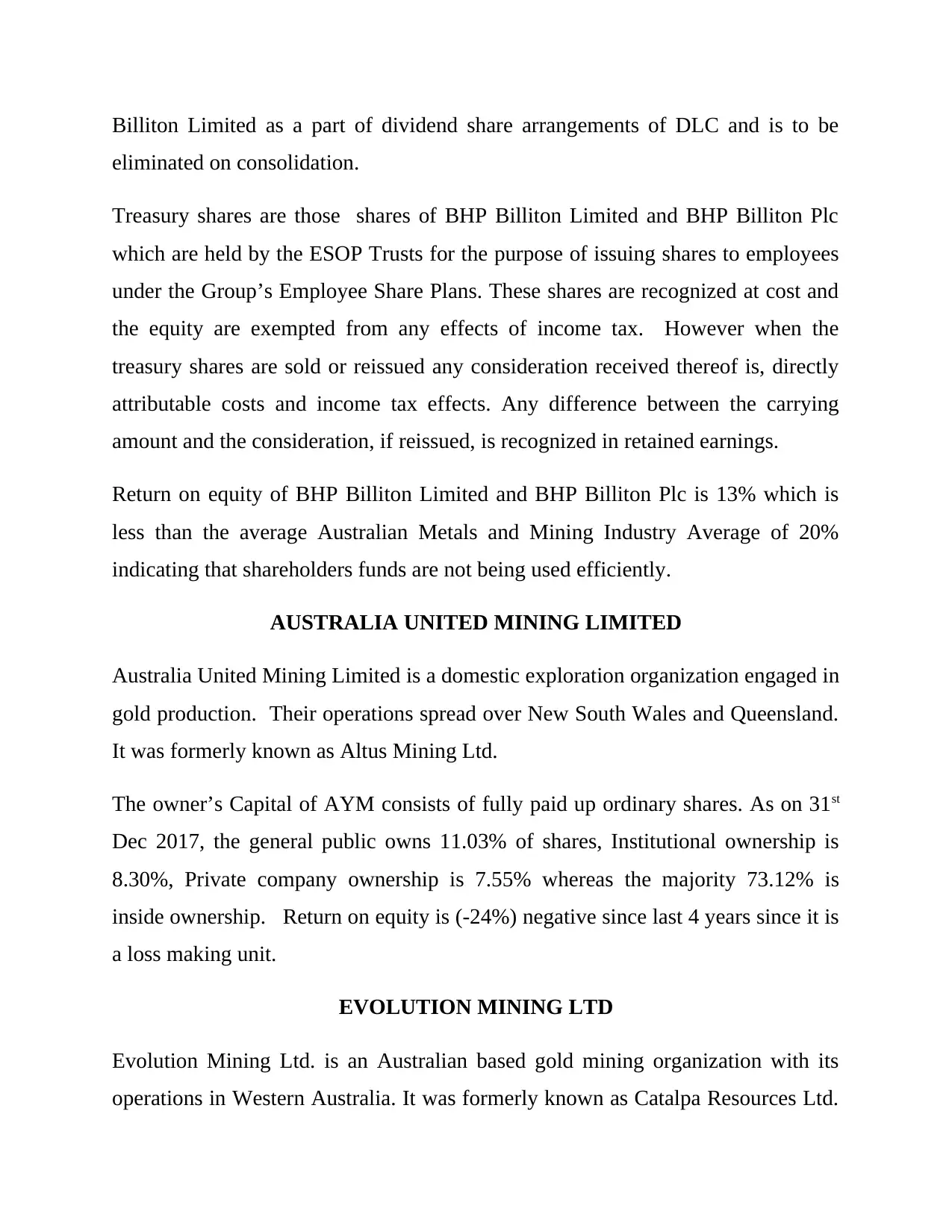
Billiton Limited as a part of dividend share arrangements of DLC and is to be
eliminated on consolidation.
Treasury shares are those shares of BHP Billiton Limited and BHP Billiton Plc
which are held by the ESOP Trusts for the purpose of issuing shares to employees
under the Group’s Employee Share Plans. These shares are recognized at cost and
the equity are exempted from any effects of income tax. However when the
treasury shares are sold or reissued any consideration received thereof is, directly
attributable costs and income tax effects. Any difference between the carrying
amount and the consideration, if reissued, is recognized in retained earnings.
Return on equity of BHP Billiton Limited and BHP Billiton Plc is 13% which is
less than the average Australian Metals and Mining Industry Average of 20%
indicating that shareholders funds are not being used efficiently.
AUSTRALIA UNITED MINING LIMITED
Australia United Mining Limited is a domestic exploration organization engaged in
gold production. Their operations spread over New South Wales and Queensland.
It was formerly known as Altus Mining Ltd.
The owner’s Capital of AYM consists of fully paid up ordinary shares. As on 31st
Dec 2017, the general public owns 11.03% of shares, Institutional ownership is
8.30%, Private company ownership is 7.55% whereas the majority 73.12% is
inside ownership. Return on equity is (-24%) negative since last 4 years since it is
a loss making unit.
EVOLUTION MINING LTD
Evolution Mining Ltd. is an Australian based gold mining organization with its
operations in Western Australia. It was formerly known as Catalpa Resources Ltd.
eliminated on consolidation.
Treasury shares are those shares of BHP Billiton Limited and BHP Billiton Plc
which are held by the ESOP Trusts for the purpose of issuing shares to employees
under the Group’s Employee Share Plans. These shares are recognized at cost and
the equity are exempted from any effects of income tax. However when the
treasury shares are sold or reissued any consideration received thereof is, directly
attributable costs and income tax effects. Any difference between the carrying
amount and the consideration, if reissued, is recognized in retained earnings.
Return on equity of BHP Billiton Limited and BHP Billiton Plc is 13% which is
less than the average Australian Metals and Mining Industry Average of 20%
indicating that shareholders funds are not being used efficiently.
AUSTRALIA UNITED MINING LIMITED
Australia United Mining Limited is a domestic exploration organization engaged in
gold production. Their operations spread over New South Wales and Queensland.
It was formerly known as Altus Mining Ltd.
The owner’s Capital of AYM consists of fully paid up ordinary shares. As on 31st
Dec 2017, the general public owns 11.03% of shares, Institutional ownership is
8.30%, Private company ownership is 7.55% whereas the majority 73.12% is
inside ownership. Return on equity is (-24%) negative since last 4 years since it is
a loss making unit.
EVOLUTION MINING LTD
Evolution Mining Ltd. is an Australian based gold mining organization with its
operations in Western Australia. It was formerly known as Catalpa Resources Ltd.
Paraphrase This Document
Need a fresh take? Get an instant paraphrase of this document with our AI Paraphraser
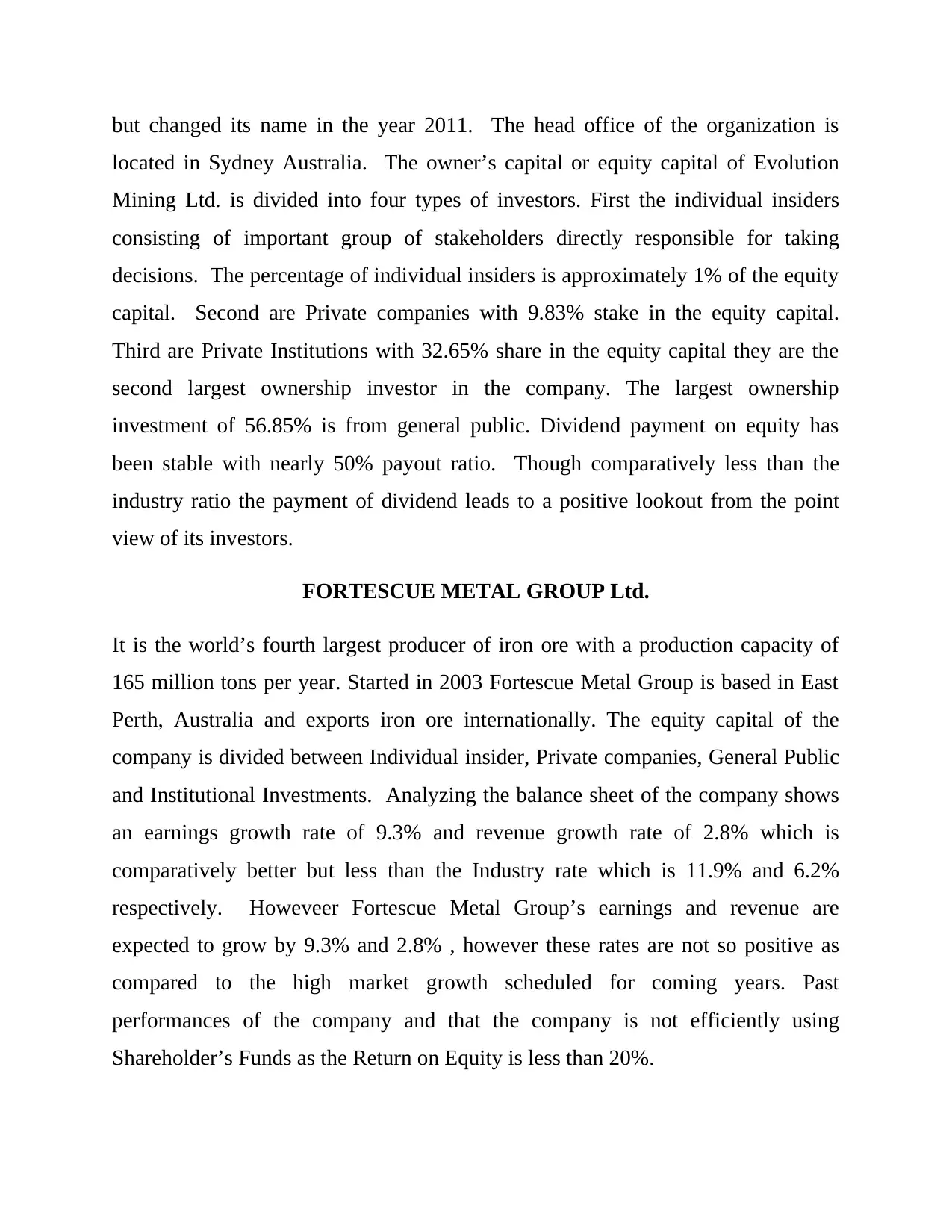
but changed its name in the year 2011. The head office of the organization is
located in Sydney Australia. The owner’s capital or equity capital of Evolution
Mining Ltd. is divided into four types of investors. First the individual insiders
consisting of important group of stakeholders directly responsible for taking
decisions. The percentage of individual insiders is approximately 1% of the equity
capital. Second are Private companies with 9.83% stake in the equity capital.
Third are Private Institutions with 32.65% share in the equity capital they are the
second largest ownership investor in the company. The largest ownership
investment of 56.85% is from general public. Dividend payment on equity has
been stable with nearly 50% payout ratio. Though comparatively less than the
industry ratio the payment of dividend leads to a positive lookout from the point
view of its investors.
FORTESCUE METAL GROUP Ltd.
It is the world’s fourth largest producer of iron ore with a production capacity of
165 million tons per year. Started in 2003 Fortescue Metal Group is based in East
Perth, Australia and exports iron ore internationally. The equity capital of the
company is divided between Individual insider, Private companies, General Public
and Institutional Investments. Analyzing the balance sheet of the company shows
an earnings growth rate of 9.3% and revenue growth rate of 2.8% which is
comparatively better but less than the Industry rate which is 11.9% and 6.2%
respectively. Howeveer Fortescue Metal Group’s earnings and revenue are
expected to grow by 9.3% and 2.8% , however these rates are not so positive as
compared to the high market growth scheduled for coming years. Past
performances of the company and that the company is not efficiently using
Shareholder’s Funds as the Return on Equity is less than 20%.
located in Sydney Australia. The owner’s capital or equity capital of Evolution
Mining Ltd. is divided into four types of investors. First the individual insiders
consisting of important group of stakeholders directly responsible for taking
decisions. The percentage of individual insiders is approximately 1% of the equity
capital. Second are Private companies with 9.83% stake in the equity capital.
Third are Private Institutions with 32.65% share in the equity capital they are the
second largest ownership investor in the company. The largest ownership
investment of 56.85% is from general public. Dividend payment on equity has
been stable with nearly 50% payout ratio. Though comparatively less than the
industry ratio the payment of dividend leads to a positive lookout from the point
view of its investors.
FORTESCUE METAL GROUP Ltd.
It is the world’s fourth largest producer of iron ore with a production capacity of
165 million tons per year. Started in 2003 Fortescue Metal Group is based in East
Perth, Australia and exports iron ore internationally. The equity capital of the
company is divided between Individual insider, Private companies, General Public
and Institutional Investments. Analyzing the balance sheet of the company shows
an earnings growth rate of 9.3% and revenue growth rate of 2.8% which is
comparatively better but less than the Industry rate which is 11.9% and 6.2%
respectively. Howeveer Fortescue Metal Group’s earnings and revenue are
expected to grow by 9.3% and 2.8% , however these rates are not so positive as
compared to the high market growth scheduled for coming years. Past
performances of the company and that the company is not efficiently using
Shareholder’s Funds as the Return on Equity is less than 20%.
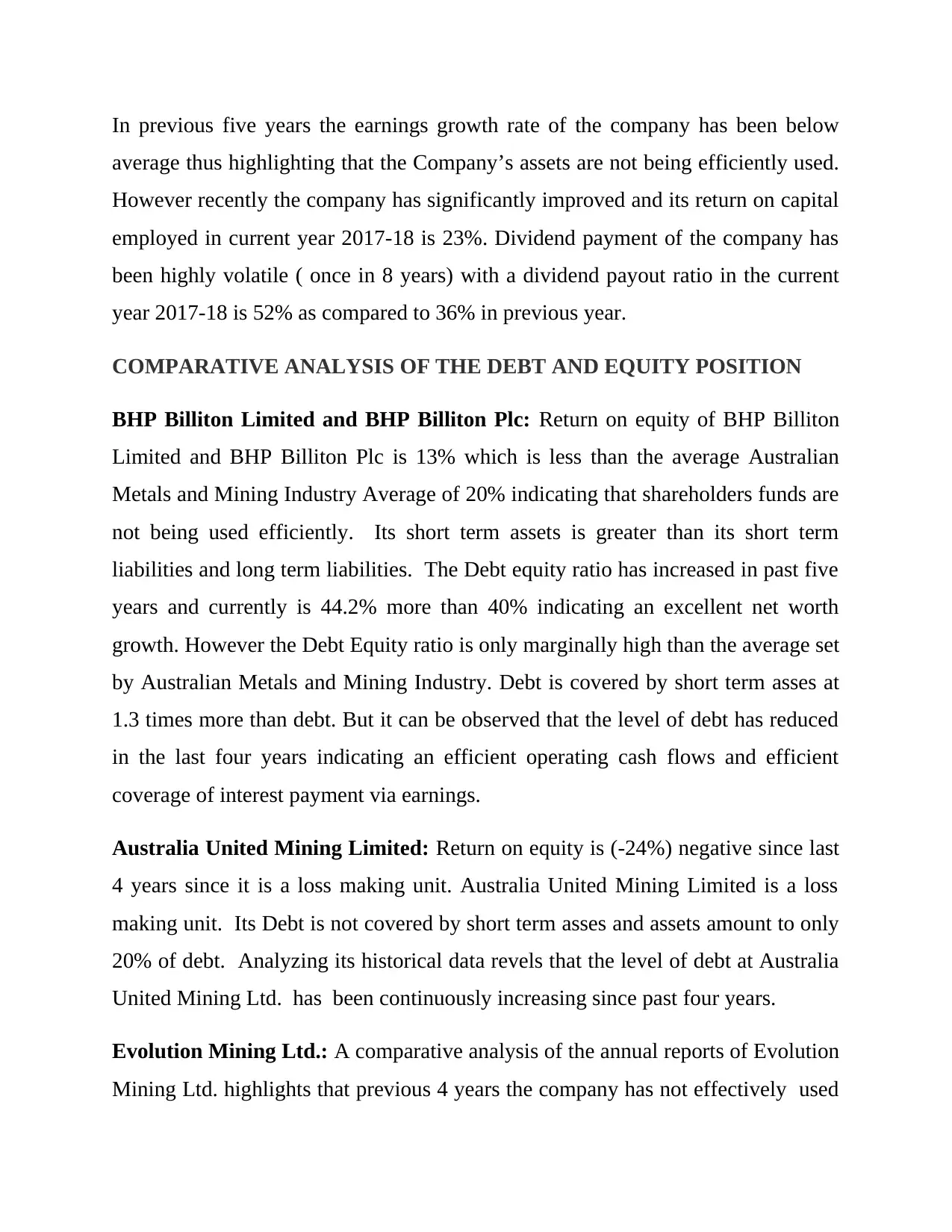
In previous five years the earnings growth rate of the company has been below
average thus highlighting that the Company’s assets are not being efficiently used.
However recently the company has significantly improved and its return on capital
employed in current year 2017-18 is 23%. Dividend payment of the company has
been highly volatile ( once in 8 years) with a dividend payout ratio in the current
year 2017-18 is 52% as compared to 36% in previous year.
COMPARATIVE ANALYSIS OF THE DEBT AND EQUITY POSITION
BHP Billiton Limited and BHP Billiton Plc: Return on equity of BHP Billiton
Limited and BHP Billiton Plc is 13% which is less than the average Australian
Metals and Mining Industry Average of 20% indicating that shareholders funds are
not being used efficiently. Its short term assets is greater than its short term
liabilities and long term liabilities. The Debt equity ratio has increased in past five
years and currently is 44.2% more than 40% indicating an excellent net worth
growth. However the Debt Equity ratio is only marginally high than the average set
by Australian Metals and Mining Industry. Debt is covered by short term asses at
1.3 times more than debt. But it can be observed that the level of debt has reduced
in the last four years indicating an efficient operating cash flows and efficient
coverage of interest payment via earnings.
Australia United Mining Limited: Return on equity is (-24%) negative since last
4 years since it is a loss making unit. Australia United Mining Limited is a loss
making unit. Its Debt is not covered by short term asses and assets amount to only
20% of debt. Analyzing its historical data revels that the level of debt at Australia
United Mining Ltd. has been continuously increasing since past four years.
Evolution Mining Ltd.: A comparative analysis of the annual reports of Evolution
Mining Ltd. highlights that previous 4 years the company has not effectively used
average thus highlighting that the Company’s assets are not being efficiently used.
However recently the company has significantly improved and its return on capital
employed in current year 2017-18 is 23%. Dividend payment of the company has
been highly volatile ( once in 8 years) with a dividend payout ratio in the current
year 2017-18 is 52% as compared to 36% in previous year.
COMPARATIVE ANALYSIS OF THE DEBT AND EQUITY POSITION
BHP Billiton Limited and BHP Billiton Plc: Return on equity of BHP Billiton
Limited and BHP Billiton Plc is 13% which is less than the average Australian
Metals and Mining Industry Average of 20% indicating that shareholders funds are
not being used efficiently. Its short term assets is greater than its short term
liabilities and long term liabilities. The Debt equity ratio has increased in past five
years and currently is 44.2% more than 40% indicating an excellent net worth
growth. However the Debt Equity ratio is only marginally high than the average set
by Australian Metals and Mining Industry. Debt is covered by short term asses at
1.3 times more than debt. But it can be observed that the level of debt has reduced
in the last four years indicating an efficient operating cash flows and efficient
coverage of interest payment via earnings.
Australia United Mining Limited: Return on equity is (-24%) negative since last
4 years since it is a loss making unit. Australia United Mining Limited is a loss
making unit. Its Debt is not covered by short term asses and assets amount to only
20% of debt. Analyzing its historical data revels that the level of debt at Australia
United Mining Ltd. has been continuously increasing since past four years.
Evolution Mining Ltd.: A comparative analysis of the annual reports of Evolution
Mining Ltd. highlights that previous 4 years the company has not effectively used
⊘ This is a preview!⊘
Do you want full access?
Subscribe today to unlock all pages.

Trusted by 1+ million students worldwide
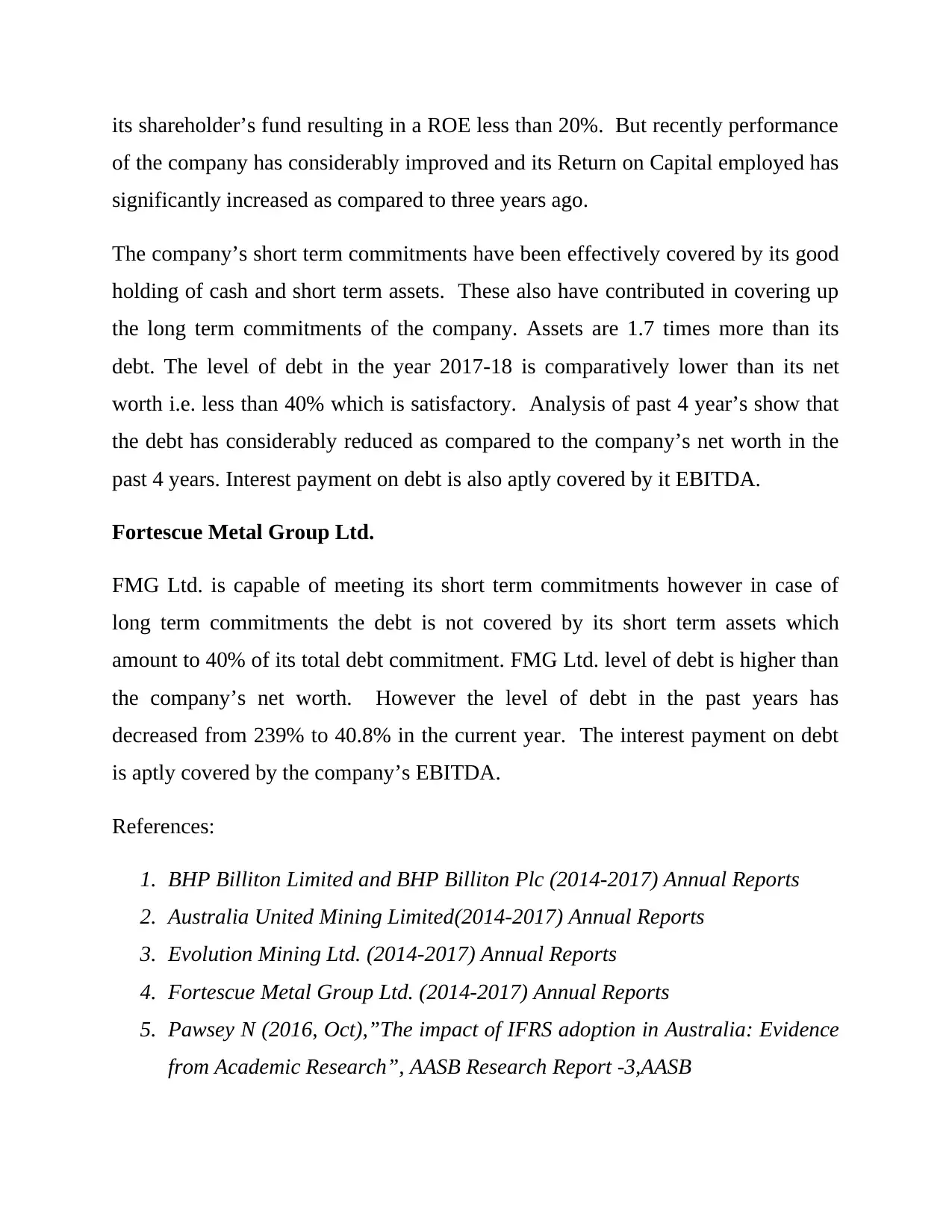
its shareholder’s fund resulting in a ROE less than 20%. But recently performance
of the company has considerably improved and its Return on Capital employed has
significantly increased as compared to three years ago.
The company’s short term commitments have been effectively covered by its good
holding of cash and short term assets. These also have contributed in covering up
the long term commitments of the company. Assets are 1.7 times more than its
debt. The level of debt in the year 2017-18 is comparatively lower than its net
worth i.e. less than 40% which is satisfactory. Analysis of past 4 year’s show that
the debt has considerably reduced as compared to the company’s net worth in the
past 4 years. Interest payment on debt is also aptly covered by it EBITDA.
Fortescue Metal Group Ltd.
FMG Ltd. is capable of meeting its short term commitments however in case of
long term commitments the debt is not covered by its short term assets which
amount to 40% of its total debt commitment. FMG Ltd. level of debt is higher than
the company’s net worth. However the level of debt in the past years has
decreased from 239% to 40.8% in the current year. The interest payment on debt
is aptly covered by the company’s EBITDA.
References:
1. BHP Billiton Limited and BHP Billiton Plc (2014-2017) Annual Reports
2. Australia United Mining Limited(2014-2017) Annual Reports
3. Evolution Mining Ltd. (2014-2017) Annual Reports
4. Fortescue Metal Group Ltd. (2014-2017) Annual Reports
5. Pawsey N (2016, Oct),”The impact of IFRS adoption in Australia: Evidence
from Academic Research”, AASB Research Report -3,AASB
of the company has considerably improved and its Return on Capital employed has
significantly increased as compared to three years ago.
The company’s short term commitments have been effectively covered by its good
holding of cash and short term assets. These also have contributed in covering up
the long term commitments of the company. Assets are 1.7 times more than its
debt. The level of debt in the year 2017-18 is comparatively lower than its net
worth i.e. less than 40% which is satisfactory. Analysis of past 4 year’s show that
the debt has considerably reduced as compared to the company’s net worth in the
past 4 years. Interest payment on debt is also aptly covered by it EBITDA.
Fortescue Metal Group Ltd.
FMG Ltd. is capable of meeting its short term commitments however in case of
long term commitments the debt is not covered by its short term assets which
amount to 40% of its total debt commitment. FMG Ltd. level of debt is higher than
the company’s net worth. However the level of debt in the past years has
decreased from 239% to 40.8% in the current year. The interest payment on debt
is aptly covered by the company’s EBITDA.
References:
1. BHP Billiton Limited and BHP Billiton Plc (2014-2017) Annual Reports
2. Australia United Mining Limited(2014-2017) Annual Reports
3. Evolution Mining Ltd. (2014-2017) Annual Reports
4. Fortescue Metal Group Ltd. (2014-2017) Annual Reports
5. Pawsey N (2016, Oct),”The impact of IFRS adoption in Australia: Evidence
from Academic Research”, AASB Research Report -3,AASB
Paraphrase This Document
Need a fresh take? Get an instant paraphrase of this document with our AI Paraphraser
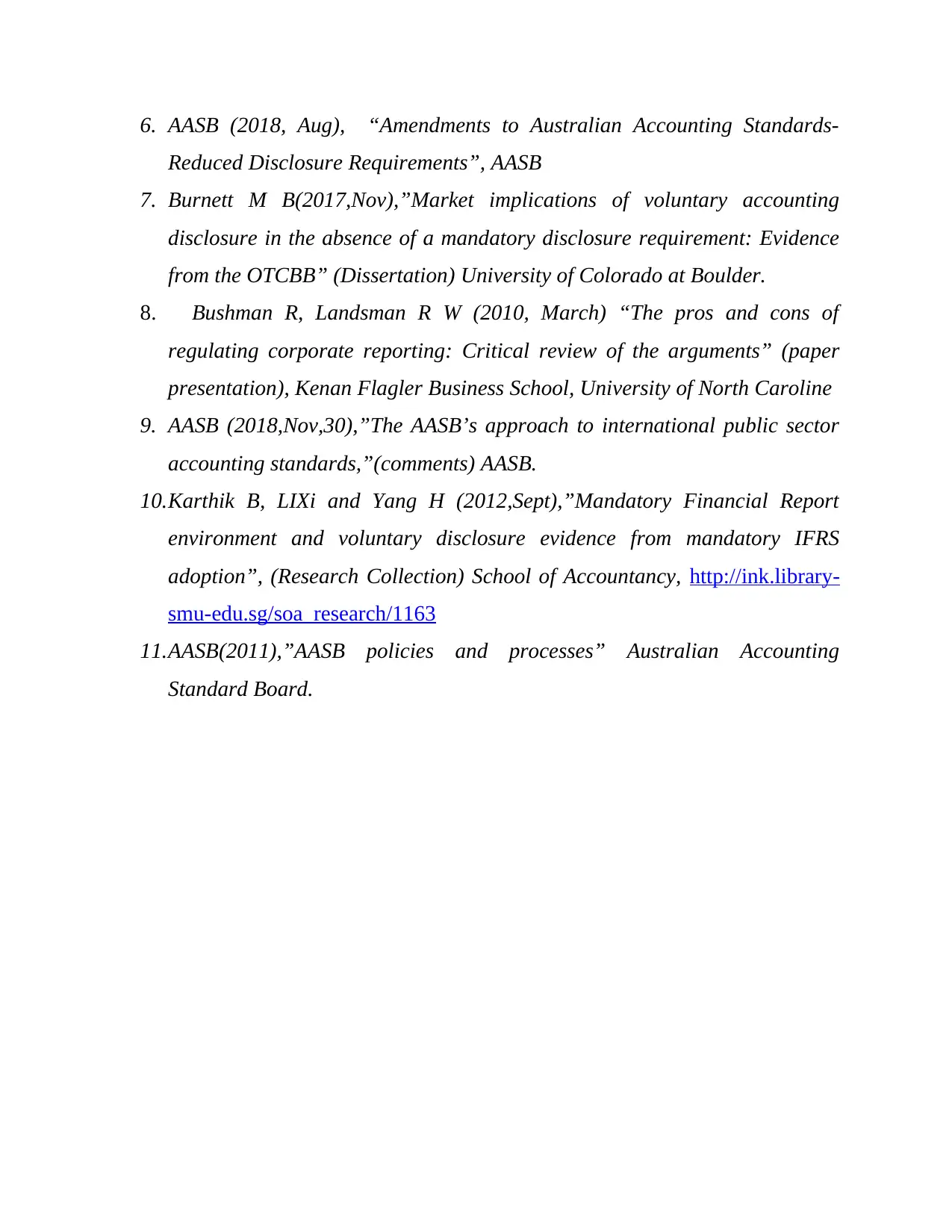
6. AASB (2018, Aug), “Amendments to Australian Accounting Standards-
Reduced Disclosure Requirements”, AASB
7. Burnett M B(2017,Nov),”Market implications of voluntary accounting
disclosure in the absence of a mandatory disclosure requirement: Evidence
from the OTCBB” (Dissertation) University of Colorado at Boulder.
8. Bushman R, Landsman R W (2010, March) “The pros and cons of
regulating corporate reporting: Critical review of the arguments” (paper
presentation), Kenan Flagler Business School, University of North Caroline
9. AASB (2018,Nov,30),”The AASB’s approach to international public sector
accounting standards,”(comments) AASB.
10.Karthik B, LIXi and Yang H (2012,Sept),”Mandatory Financial Report
environment and voluntary disclosure evidence from mandatory IFRS
adoption”, (Research Collection) School of Accountancy, http://ink.library-
smu-edu.sg/soa_research/1163
11.AASB(2011),”AASB policies and processes” Australian Accounting
Standard Board.
Reduced Disclosure Requirements”, AASB
7. Burnett M B(2017,Nov),”Market implications of voluntary accounting
disclosure in the absence of a mandatory disclosure requirement: Evidence
from the OTCBB” (Dissertation) University of Colorado at Boulder.
8. Bushman R, Landsman R W (2010, March) “The pros and cons of
regulating corporate reporting: Critical review of the arguments” (paper
presentation), Kenan Flagler Business School, University of North Caroline
9. AASB (2018,Nov,30),”The AASB’s approach to international public sector
accounting standards,”(comments) AASB.
10.Karthik B, LIXi and Yang H (2012,Sept),”Mandatory Financial Report
environment and voluntary disclosure evidence from mandatory IFRS
adoption”, (Research Collection) School of Accountancy, http://ink.library-
smu-edu.sg/soa_research/1163
11.AASB(2011),”AASB policies and processes” Australian Accounting
Standard Board.
1 out of 11
Related Documents
Your All-in-One AI-Powered Toolkit for Academic Success.
+13062052269
info@desklib.com
Available 24*7 on WhatsApp / Email
![[object Object]](/_next/static/media/star-bottom.7253800d.svg)
Unlock your academic potential
Copyright © 2020–2025 A2Z Services. All Rights Reserved. Developed and managed by ZUCOL.




